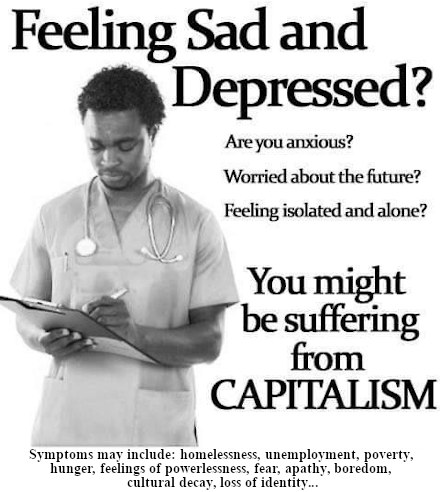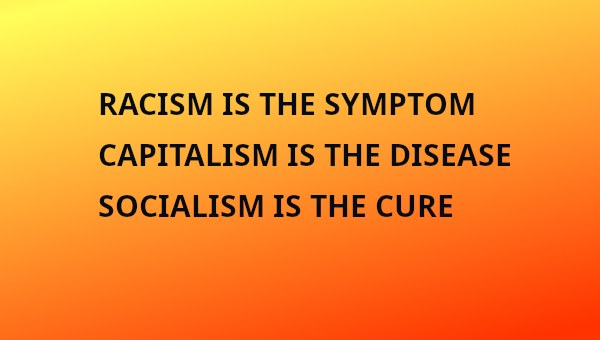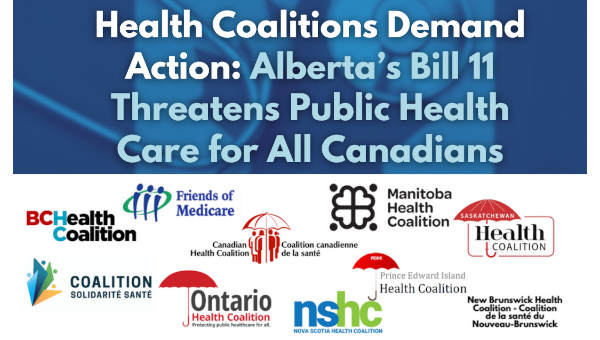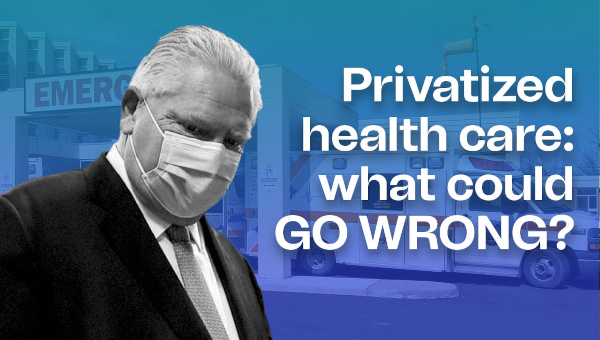Does Capitalism Make Us Crazy?
Does capitalism make us crazy? The short answer is YES! Life under capitalist rule is perilous. We can’t survive on our own, and we can’t rely on society to support us. We live with perpetual uncertainty: Can I pay my bills? Will I lose my home, my job? What happens if I’m sick or injured? Add the constant threat of racism, war, and climate change disasters.
Do you feel safe in this world? I don’t. Every morning, I wake up with a sense of dread, thinking, “OMG. I’m still here, and this is still happening.” I am not alone in this.
A ten-country survey of 10,000 young people, aged 16 to 25, inquired what they thought and felt about climate change. Sixty percent felt very or extremely worried. More than half felt sad, anxious, angry, powerless, helpless, and guilty. Seventy-seven percent saw the future as frightening, and 56 percent believe that humanity is doomed. This breaks my heart. And it shows how desperately we need a social revolution.
Psychologists see it differently. The Good Grief Network offers:
“A unique 10-Step Program to help individuals and communities build resilience by creating spaces where people can lean into their painful feelings about the state of the world and reorient their lives toward meaningful action.”
The American Psychological Association advises fostering optimism, creating household emergency plans, and expanding mental-health services.
Promoting a false sense of control is no substitute for the real control we could have by organizing to end capitalist rule and ALL the miseries it creates.
Bamboozled
Marxists approach every problem from the perspective that there are two social classes, and what benefits the one harms the other.
For capitalists to accumulate capital, they must deny ordinary people any meaningful control over their work, their lives, or the direction of society. It’s a huge challenge to trap a highly social species in such a dehumanizing social arrangement. Capitalists must block workers from taking collective control, insist that their suffering is their own fault, promote ineffective solutions, and treat all protest as criminal or pathological.
Force alone is insufficient. Workers vastly outnumber capitalists, are intelligent problem-solvers, and run the machinery of society. They must be systematically bamboozled into resigning themselves to capitalist rule. Psychology serves to solicit and police this resignation with the message, “Accept what is, and we will help you build a bubble in which you can function.”
Denied the information, tools, and social power to actually secure our safety, psychology directs us to build imaginary bubbles that give us the illusion of safety. Individual bubbles confirm our belief that we can only count on ourselves. Friend, family, and group bubbles form around shared interests or activities. While these bubbles provide a sense of connection and shared reality, they are fragile and easily ruptured. Under the strain of this pandemic, more people are losing their jobs and homes, relationships are breaking down, and murder rates and drug-related deaths are at record highs.
Marxism vs Psychology
While psychology is a broad discipline with many branches, all psychological disciplines share a common theoretical foundation that conflicts with Marxism:
- Marxism examines society from a class-struggle perspective. Psychology examines society from an individual perspective.
- Psychology assumes two separate realms: a public, economic realm governed by capitalism and a private, psychological realm governed by psychology. Marxists insist that we live in one realm, a capitalist realm that shapes every aspect of life.
- Marxism aims to transform human experience through social revolution. Psychology strives to adapt individuals to capitalism as an alternative to social revolution.
- Marxism offers the possibility of a caring socialist society. Psychology offers caring relationships as a substitute for a caring society.
While academics strive to integrate Marxism and psychology, these contradictions make it impossible. We don’t need a psychological model to explain mass suffering under capitalism; we can use the Marxist method to explain it and, more importantly, show us how to end it.
The Threat Response
All living organisms respond to threat with an automatic biological defense system. In mammals, this threat response takes the form of flight, fight, or freeze. Which one of these is activated depends on a split-second, subconscious assessment of what will best secure survival.
Once the threat response is activated, a cascade of stress hormones, including adrenaline, surges through our bodies, activating our immune system, raising blood pressure, making our heart pound, breathing quickens, and muscles tense, preparing us to flee, fight, or freeze. This emergency response evolved to be short-lived. You escape the lion or you don’t.
Under capitalism, threat is ever-present and seemingly inescapable. Those with the least social power experience the greatest threat.
“As a Black man in America, I am kept awake by the absolute helplessness of being in my shoes, the fear and anger and confusion. There is no pairing of words or public display that will ever get you to understand what it’s like to walk and breathe and live in constant fear of being yourself. That when I say I am Black and proud, and when I say my life matters, someone will be there every time to deny it. To judge it and mock it. And to take it from me.”
Being threatened, remembering being threatened, and anticipating being threatened can all activate the human threat response. In the 1950s, Hans Selye discovered that conditions of sustained threat lead to exhaustion, then organ failure, then premature death.
While we may seem to cope on the surface, our insides are protesting with chronic pain, insomnia, digestive and respiratory problems, diabetes, heart disease, and immune system disorders, to name just a few.
Inequality is a Threat
For hundreds of thousands of years, our ancestors relied on strong social bonds to survive. Inequality ruptures social relationships, so hunter-gatherer societies were fiercely egalitarian. They would not tolerate boasting or arrogance. Their first line of defense was ridicule. If anyone acted superior, the rest of the group, and especially the elders, would ridicule that person until proper humility was shown.
In contrast, capitalists celebrate inequality as a sign of their success in extracting capital. The result is mass activation of the threat response.
Our bodies know our place in the class hierarchy, even when we don’t. Children show rising levels of stress hormones as their social position falls. Simply speaking with someone of higher social status will raise your blood pressure. Over the past three decades, inequality has increased, and the prevalence of high blood pressure has doubled.

One study measured the threat response of high-school students all of whom were doing well academically. Upper-class students showed a brief spike of stress hormones followed by a quick decline, while working-class students showed a prolonged rise of stress hormones that took longer to decline. These students experience more background threats that keep their threat response activated.
A 1998 study of 282 metropolitan areas in the United States found that greater income inequality was directly linked with higher death rates at all income levels. Researchers calculated that reducing inequality to the level found in the areas with the lowest inequality (not eliminating inequality, just reducing it) would save as many lives as would be saved by eradicating heart disease or by preventing all deaths from lung cancer, diabetes, motor vehicle crashes, HIV infection, homicide, and suicide combined.
Another study, released just this month, supports these findings. Before the 1990s, average life expectancy in the US was similar to that in Germany, the UK, or France. Since then, inequality has surged in the US, and American life spans have fallen. Now, at every age, Americans die earlier than their European counterparts. Even extremely impoverished Europeans live longer than wealthy Americans.
There have been many, many such studies.
ACE Study
Consider the Adverse Childhood Experiences (ACE) study, the largest ongoing investigation into the connection between adverse childhood experiences and adult health.
As the number of adverse childhood experiences rises, there is a corresponding increase in physical, psychological, and social problems, including: lung, heart, and liver disease; diabetes; obesity; intimate partner violence; adolescent pregnancy; bone fractures; cancer; chronic pain; tobacco, alcohol, and drug addiction; attempted suicide; premature death; and all forms of mental distress.
Racialized people, poor people, and gender rebels suffer significantly more adverse effects in childhood and, as a result, more physical, psychological, and social difficulties as adults.
While these findings have never been refuted, they have not been incorporated into capitalist medicine.
Regardless of the cause of their problems, all sufferers are directed to consult a physician. With social supports decimated by austerity policies, the only remedies on offer are drugs, but not all drugs, only those produced by the medical-pharmaceutical industry. So the doctor reaches for the prescription pad, cementing the mistaken belief that suffering is an individual medical problem and not the inevitable consequence of capitalist oppression.
Sounding the Alarm
The flight, fight, and freeze responses are involved in all forms of mental distress. The flight response can be expressed as addictions, obsessions, and compulsions that enable us to hide from what we cannot bear. The fight response can be expressed as irritability, anger, or rage directed at the self or others. The freeze response can be expressed as depression, numbness, or dissociation.
Dissociation was first identified in the late 19th century by Jean-Martin Charcot, a physician working at a Paris asylum. Charcot was deeply affected by the mass rebellion that peaked in the Paris Commune (March to May, 1871). Instead of dismissing his patients as raving lunatics, he listened to their stories of trauma and abuse.
Charcot’s student, Pierre Janet, proposed that some experiences are so overwhelming that they cannot be integrated into a person’s understanding of the world, so they are split off from conscious awareness. These dissociated fragments of traumatic experience can intrude into a person’s consciousness as distressing thoughts, feelings, and images that sufferers try to block with obsessive thoughts and compulsive rituals. While such behavior may seem crazy, Janet insisted that dissociation helps people manage unbearable trauma by psychologically disconnecting them from the experience.
Some traumatized children of refugees sink into a coma-like state called resignation syndrome. They cannot be roused and must be nourished through feeding tubes. Dissociation offers these children an escape from what they cannot face.
Dissociation explains why the majority put up with capitalist barbarism. If you can’t change anything, why try? Why even think about it? You’ve probably experienced this. You’re talking with someone and their eyes glaze over. Psychologically, they are no longer present, because what you are saying is too distressing for them to process.
The fight response keeps the nervous system on ‘high alert’ to the slightest hint of danger. This hyper-arousal is expressed as restlessness, hyper-activity, or emotional excitability.
Hyper-arousal inevitably leads to exhaustion that is expressed as fatigue, numbness, or depression. Sufferers can alternate between anxious hyper-arousal and exhausted depression. Both are intensely uncomfortable, compelling many to self-medicate with tobacco, alcohol, and other drugs. Distracting activities in the form of obsessions and compulsions can also provide relief.
When hyper-arousal becomes overwhelming, a person’s sense of self may start to disintegrate, making it difficult to know what is real. Such altered states can feel extremely threatening and contribute to further hyper-arousal and more disintegration. When there is no hope of relief, suicide offers the ultimate escape.
The Brain-Body
What I’ve just explained is not common knowledge, because the majority are not taught human anatomy and physiology in school (other than reproductive plumbing). Alienating us from knowledge of our bodies makes us dependent on experts who can feed us false information. If you had a basic understanding of the human body, you would know that what we call the mind is a complete fiction.
The human brain floats inside a dark and silent bony cage. Its function is to make sense of the world it inhabits by minding the 100 million messages per second it receives from every cell in the body. The brain references, interprets, and responds to this information, correcting course as new information arrives. This process of minding the internal and external environment is what the brain-body does. We think with our entire bodies, we feel with our entire bodies, and we experience and respond to capitalism with our entire bodies.
A brain can be healthy, sick, or diseased because the brain is a physical organ. What we call ‘the mind’ can be none of these things because ‘the mind’ is not an organ but a function. Minding is what the brain-body does.
Consider the dancer and the dance. The dance is not a thing; it is the activity of the dancer, just as ‘the mind’ is the activity of the brain-body. If we declare the dance or the mind to be healthy, sick, or diseased, then we are using these terms as stand-ins for acceptable and unacceptable, which makes them value judgments, not medical assessments.
The claim that ‘the mind’ can be sick or diseased only makes sense if ‘the mind’ is reduced to the brain and if the brain is separated from the body and its social environment. The concepts of mental health, mental illness, and mental disease do just that. To serve the capitalist system, psychology extracts the individual from society, splits the brain from the body, and drugs the brain in order to change the mind or, at least, silence the sufferer.
‘Balancing’ Brain Chemicals?
It is commonly believed that mental suffering is caused by an imbalance of chemicals in the brain that can be corrected with psychiatric drugs. This would be laughable if it didn’t result in such tremendous harm.
Recall that the nervous system transmits 100 million messages per second to the brain. This means the chemistry of the brain is constantly changing. It’s impossible to measure the composition of chemicals in a living brain. Even if you could, it would be different the next second and the second after that.
When a drug raises the level of hormones, such as serotonin or dopamine, the brain responds by culling receptors for those hormones. In other words, psychiatric drugs create a chemical imbalance in the brain that the brain attempts to correct. This is why reducing or quitting these drugs leaves the person hormone deficient, creating the very condition the drug was promoted to cure.
Globally, psychiatric drugs are a $30 billion-a-year industry based on a lie. The theory that mental distress is caused by an imbalance of chemicals in the brain is no more valid than the theory that physical disease is caused by an imbalance of humors in the blood. We would all know this if we had a basic knowledge of anatomy and physiology. So why don’t doctors know it?
Many do, and quite a few protest. However, the pharmaceutical industry uses its financial and political clout to discredit critics who expose its fraudulent theories, defective research, and harmful practices.
What is Crazy?
In popular speech, ‘crazy’ means ‘outside a shared sense of reality,’ for example, “That’s crazy!”
There is no shared sense of reality under capitalism. Capitalists cannot allow it. To sustain their rule, they must impose their interpretation of reality on everyone else. As Marx observed, the ideas that dominate society are those that serve the dominant class.
For example, to hide the health-damaging reality of exploitation, workers’ lived experience must be denied or dismissed. This is crazy-making.
Alienated work makes people sick, and they get sicker when denied time off work to recover. However, the myth that work is healthy implies that sick or injured workers must be malingering and should be challenged for their own good. The disabled worker is trapped in a crazy-making nightmare where their suffering is discounted, and they are pressured to return to work or quit, relieving employers and insurers of any further obligation.
Divide and Rule
We cannot experience the world outside of us directly. We can only interpret it through our senses. This interpretation, our sense of reality, depends on the social context.
Alienation disconnects our understanding of reality from that of others. More than one in four Americans believe the 2020 election was stolen from Donald Trump, and nine percent believe that use of force is justified to restore him to the presidency. More than half this group believe that “A secret group of Satan-worshipping pedophiles is ruling the US government.”
Capitalist ideology is full of crazy-making contradictions: We are told that racist inequality is based on biological differences; and we are told that anyone can make it if they try. ‘Free markets’ are based on wage slavery; imperialism parades as liberation; and war poses as humanitarian intervention.
Working-class behavior, such as striking, seems crazy to the middle and capitalist classes. And while destroying the environment for profit makes sense to the ruling class, it seems crazy to everyone else. Women and men do not share the same sense of reality, nor do White and Black people. The COVID-vaccinated think it’s crazy to reject the vaccine, while anti-vaxxers think it’s crazy to trust the vaccine. The majority are actively discouraged from understanding what life is like for refugees, immigrants, the unhoused, the addicted, the disabled, and victims of war.
If a shared sense of reality is required for sanity, then capitalism makes us all crazy.
Capitalists share a common understanding of reality. They know there are two classes, and what benefits the one hurts the other. If they allowed the majority to share that understanding, then workers would have no reason to tolerate capitalist rule and every reason to replace it with international cooperation.
To prevent a shared sense of reality, capitalists employ a class of professionals, experts, and bureaucrats to manage the perceptions and expectations of the working class.
The Provincial Health Officer for British Columbia recently announced that public release of information about COVID cases in schools would be limited because parents find it too anxiety provoking. In other words, if you knew the truth, you would be frightened, so we won’t tell you. The public are treated like children whose fears must be managed by superior beings with more emotional control.
All super-hero stories assume that ordinary people must be shielded from the truth or they will panic and behave irrationally. In the pilot episode of Marvel’s Agents of SHIELD, a new agent is asked if he understands SHIELD’s mission. He replies, “We protect people from news they’re not ready to hear.” From the earliest age, we are taught that solving social problems is best left to stronger, wiser beings.
Marxism rips away the curtain of capitalist deception by declaring that there are two social classes, and what benefits the one hurts the other. Once that understanding of reality is widely shared, only one question remains: which side are you on?
What to do Now?
At this point, someone typically asks, “That’s all very well, but what do we do now? People are suffering now. We can’t wait for the revolution to help them.” There are two things we can do now. The first is, tell the truth.
Mental suffering is not a medical defect, but a protest against oppression. Attribution matters. It makes a huge difference to know that you are not crazy, that your suffering is a reasonable response to unreasonable conditions. We must validate the lived experience of oppression and place responsibility where it belongs, with the capitalist system and those who manage it.
Second, we need to demand that people be provided with solutions that work for them. Psychological approaches work best for those whose basic needs are met. They don’t work for the majority whose suffering is rooted in deprivation and oppression.
People in crisis need a safe space where their autonomy is assured and their needs are met for as long as necessary. Instead of providing such support, capitalism subjects the sufferer to stigmatization, forced detention, and harmful medical interventions.

Build a Shared Reality
Social problems demand social solutions. The personal support that individuals can give each other is limited and difficult to sustain. The only way to end social suffering is to fight for a socialist society that supports all its members without exception. Every increase in social support we win is a step in the right direction. The fight itself is therapeutic.
While capitalists treat the collective as a source of danger, psychologists at the University of Sussex found that activists who engage in strikes and political demonstrations report a sense of strength and mutual support that reduced feelings of pain, anxiety, and depression. According to the lead researcher,
“The development of a shared identity transforms a fragmented crowd into a collective subject capable of acting against those it sees as attacking its members or denying them their rights. Such empowered action engenders positive emotions that benefit health and well-being.”
Collective struggle is powerful medicine, and socialism is the cure we desperately need.
This article first published on the Susan Rosenthal website.





